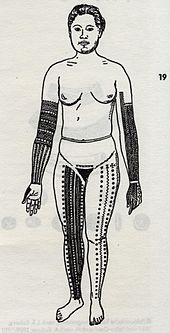Tattoo in Palau

Tattoos were in the form of traditional tattoos to the 20th century in Palau central part of culture and society, as well as an indicator of status and wealth of the wearer. The tattoos were worn by both sexes. In women, however, they were of particular importance. The tattooing was also basically done by women, who mostly belonged to higher social classes and passed the craft on to their daughters in accordance with the matrilineal society.
People without tattoos were seen in society as klemedu (naked) and women as not marriageable.
History and meaning
The size of the tattoos was seen as a sign of wealth and social status of the wearer and his clan. Members of lower social ranks could sometimes not afford tattoos. The men's tattooed areas were particularly focused on the wrists, arms and legs. Women wore patterns on their hands, arms, legs, abdomen and pubic area.

During puberty , the boys initially had their wrists and the forearm area above them tattooed and were thus integrated into the social and social life of men.
Women were initially tattooed on their hands before puberty. After the first menstruation , the pubic mound followed , the tattoo of which was considered mandatory for recognition as an adult woman. The performance was sometimes carried out on several girls at the same time and as a social event and usually took place outside the settlements. First, their pubic hair was shaved with a bamboo chip or epilated with applied and dried honey. The outlines of the motifs to be stabbed into the skin were first drawn and a trapezoidal area about ten centimeters long and two centimeters wide was colored and completely filled into the skin. Another component of the intimate tattoo was a subsequent horizontal line made of diamond ornaments above the pubic mound. The girls received physical and psychological support from assistants during the tattooing process. Ornaments were optionally tattooed in the groin region. For example, a zigzag pattern called "kikoi". The term comes from a species of mussel of the same name, whose muscles have been associated with female sexual concerns. In addition, a decorative line was also widespread on the abdomen , usually in the form of a string of dots or circled x-shaped crosses, the symbol of money, which was often used in art as a decorative element.
During the time of colonial rule, tattoos were condemned by the colonial powers as a pagan form of expression and a symbol of crime and anti-sociality , they were forbidden by law and consistently persecuted in practice.
In the 20th century the tradition almost completely disappeared. A study in 1986 counted 60 people with traditional tattoos, many of them over 90 years of age. Instead, the Palauans increasingly adapted western-influenced, modern tattoos and sometimes combined them with traditional motifs.
Technology, color and tools
Soot from a tree resin was mixed with water to produce the paint . When doing the tattoos, special combs of different sizes were used. They were first dipped into the paint and stabbed into the skin with several tapping movements. Sponges or leaves were used to wipe off blood.
Anthropological research
The tattoos were researched by the European ethnologists Augustin Krämer and Johann Stanislaus Kubary, among others . The various patterns were documented by Kubary in 1887. In 1909/1910, Krämer created a detailed overall plan of the individual tattoos on the female body.
See also
Web links
swell
- Peter Probst: The Decorated Body , Museum Education Visitor Service, Berlin: Museum für Völkerkunde, 1992
